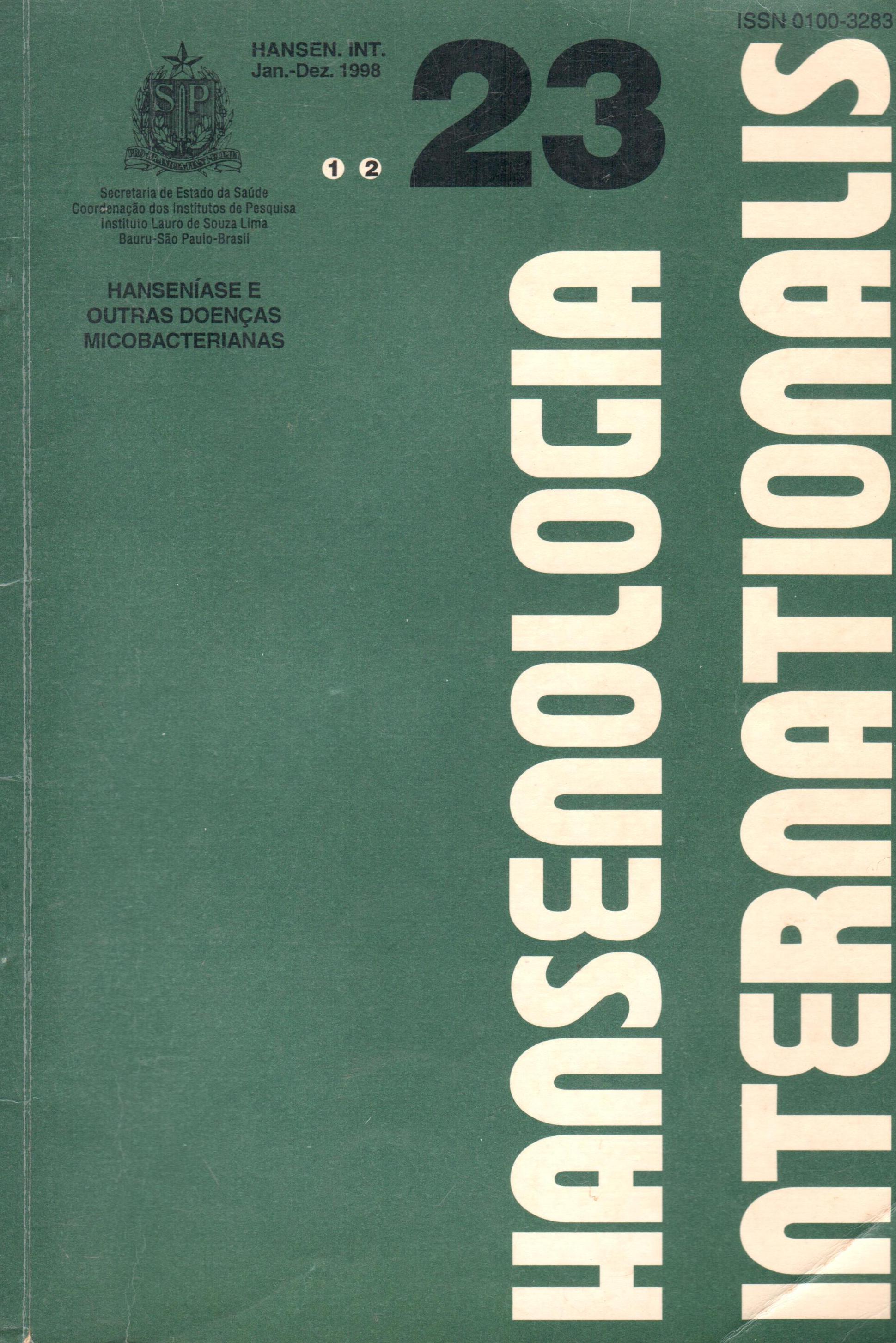Resumen
Testes cutâneos são utilizados para o acompanhamento de casos de hanseníase, pois constituem um dos parâmetros para a classificação da forma clínica da doença, prognóstico e mesmo para indicação e acompanhamento do tratamento. Estes testes foram desenvolvidos no início do século e utilizam suspensões de bacilos extraídos de lepromas humanos ou de tatus infectados. Neste artigo, revemos as características do teste da lepromina ou de Mitsuda e dos testes alternativos que foram desenvolvidos. Discutimos também o potencial da utilização de antígenos recombinantes como uma possibilidade futura para a obtenção de testes cutâneos mais específicos e mais padronizáveis em relação àqueles obtidos a partir de seres humanos ou de tatus.
Citas
2. FERNANDEZ, J.M.M. The early reaction induced by lepromin. Int. J. Leprosy, v.8, p.1-14, 1940.
3. GILL, H.K. , MUSTAFA, A.S., GODAL, T. Vaccination of human volunteers with heat - killed M. leprae: local responses in relation to the interpretation of the lepromin reaction. Int. J. Leprosy, v. 56. p.36-44, 1988.
4. GUPTE, M.D., VALLISHAYEE, R.S., ANATHARAMAN, D.S. et al. Effect of skin test with M. leprae soluble antigen on reaction to a subsequent test with the same antigen. Int. J. Leprosy, v.60, p.54-60, 1992.
5. HASTINGS, R.C., GILLIS, T.P., KRAHENBUHL, J.L. et al. Leprosy. Clin. Microbial. Rev., v.1, p.330- 348, 1988.
6. HAYASHI, Y. On a pure culture of leprosy bacilli and skin reactions by means of the pure culture syspensions. Saikin-qaku Zasshi J. Bacteriol., v.272, p.51-53, 1918. Republicado em Int. J. Leprosy, v.21, p.370-372, 1953.
7. KOOIJ, R., GERRITSEN, T. Positive 'lepromin' reactions with suspensions of normal tissue particles. Int. J. Leprosy, v.24, p.71-181, 1956.
8. KOOIJ, R. The natur of the Mitsuda reaction. Leprosy Rev., v.30, p.137-139, 1959.
9. KUMAR, B., KAUR, S., SHARMA, V.K. et al. Lepromin-H versus lepromin-A. Ind. J. Leprosy, v.56, p.50-57, 1984.
10. LARA, C.B., NOLASCO, J.O. Self - healing, or abortive, and residual forms of childhood leprosy and their probable significance. Int. J. Leprosy, v. 24, p.245-263, 1956.
11. LEIKER, D.L. Studies on the lepromin test: I. influence of tha bacillary and tissue components in dilutions of lepromin. Int. J. Leprosy, v.29, p.157-167, 1961.
12. MEHRA, V.L., SALGAME, P., SNAPPER, S.B. et al. Vaccines against leprosy. In: PLATKIN, S.A., MORTIMER JR., E. A. eds. Vaccines. Philadelphia: WB Saunders, 1988.
13. MEYERS, W.M., KVERNES, S., BINFORD, C.H. Compar ison of react ions to human and armadillo lepromins in leprosy. Int. J. Leprosy, v.43, p.128-225, 1975.
14. MITSUDA, K. On the value of a skin reaction to a suspension of leprous nodules. Hifuka Hinyôka Zasshi. Japanese Journal of Dermatology and
Urology, v,19, p.697-708, 1919. Republicado e traduzido em: Int. I. Leprosy, v.21, p.347-358, 1953.
15. NEWELL, K.W. An epidemiologist's view of leprosy. Bull. WHO, v.34, p.827-857, 1966.
16.PESSOLANI, M.C.V., HUNTER, S.W., BRENNAN, R. Relat ionship between host histones and armadillo. derived Mycobacterium leprae. Int. J. Leprosy, v. 61, p.381-388, 1993.
17. PINTO, M.R.M., ERIYAGAMA, N.B., PEMAJAYANTHA, V. Immunological effects of lepromin testing in sri Lankan population groups. II. Effect on reactivity to a soluble protein antigen of Mycobacterium leprae. Leprosy Rev v.58, p.227-232, 1987.
18. PONNINGHAUS, J.M., FINE, P.E.M. Sensitization studies with potential leprosyvaccine preparations in Northern Malawi. Int. J. Leprosy, v.54, p.25-37, 1986.
19. REES, R.J.W. Progress in the preparation of an antileprosy vaccine from armadillo-derived Mycobacterium leprae. Int. I. Leprosy, v.51, p.515-518, 1983.
20. RIDLEY, D.S., JOPLING, W.B. Classification of leprosy according to immunity. A five group system. Int. J. Leprosy, v.34, p.255-273, 1966.
21. SENGUPTA, U. Studies on lepromin and soluble antigens of M. leprae: their classification, standardization and use. Indian. J. Leprosy, v.63. p.457-463, 1991.
22. SHEPARD, C.C., DRAPER, P., REES, R.J.W. et al. Effect of purification steps on the immunogenicity of Mycobacterium leprae. Br.J. Exp. Pathol., v.61, p. 376-379, 1980.
2 3 . SHEPARD, C.C., MINAGAWA, F., VAN LANDIGHAM, R.V. et al. Foot pad enlargement a s a me a s u r e o f i n d u c e d immu n i t y t o
Mycobacterium leprae. Int. J. Leprosy, v.48, p.371-381, 1980.
24. SHIELD, M.J., STANFORD, J.L., GARBAJOSA, G. et al. The epidemiological evaluation, in burma, of the skin test reagent LRA6; a cell free extract from armadillo derived Mycobacterium leprae. Part 1: leprosy patients. Int. J. Leprosy, v. 50, p.436-445, 1982.
25. SHIELD, M.J., STANFORD, J . L . The epidemiological evaluation, in burma, of the skin test reagent LRA6: a cell free extract from armadillo derived Mycobacterium leprae. Part 2: close contacts and non-contacts of bacilliferous leprosy patients. Int. J. Leprosy, v.50, p.446-454, 1982.
26. WADE, H.W. Induction of lepromin reactivity by repeated lepromin testing. Int. J. Leprosy, v.23, p. 310-315, 1955.
2 7 . WORLD HEALTH ORGANIZATION. Recommended safety requirements for the preparation of lepromin: a WHO memorandum. Bull. WHO, v.57, p.921-923, 1979.
28. WORLD HEALTH ORGANIZATION. Leprosy. In: __________ Tropical Diseases Research: Progress 1991 - 1992. Eleventh Programme Report of the UNDP/ World Bank/ WHO special Programme for Research and Training in Tropical Diseases (TDR). Geneva: 1993. p.47-55.

Esta obra está bajo una licencia internacional Creative Commons Atribución 4.0.
